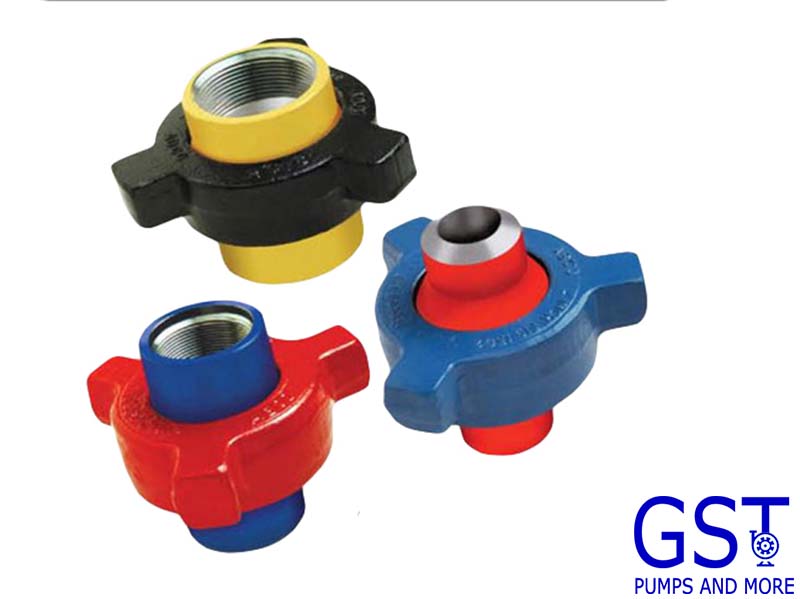Почему в нефтедобывающей промышленности выбирают крыльчатые молотковые соединения типа Weco?
May 21, 2025
Ⅰ. Определение продуктаМуфты с крыльчатым замком типа Weco с концами под сварку встык являются наиболее широко используемыми соединителями трубопроводов в нефтяной промышленности. Благодаря своей уникальной конструкции и производительности они предлагают значительные преимущества в соединениях трубопроводов высокого давления, особенно подходят для суровых условий в нефтегазовой, химической и морской технике. Разработанные с использованием технологий, внедренных такими компаниями, как FMC, некоторые компоненты взаимозаменяемы с компонентами FMC Weco той же спецификации. Корпус соединения выкован из высококачественной легированной стали (например, AISI 4130 75K), при этом процессы ковки, обработки и термообработки строго соответствуют таким стандартам, как API 6A, API 16Cи Q1.Ⅱ.Характеристики продукта1. Надежность герметизацииБлагодаря уплотнению металл-металл или композитным уплотнительным конструкциям (например, уплотнительное кольцо + металлическое кольцо) эти соединения тщательно спроектированы для выдерживания импульсов высокого давления и интенсивных вибраций. Это обеспечивает превосходную герметичность во всех сложных рабочих условиях, принципиально исключая утечку жидкости и предоставляя надежную гарантию безопасности трубопроводной системы.2. Удобство эксплуатацииКонструкция трехкрылой гайки значительно повышает эффективность эксплуатации, позволяя производить быструю ручную сборку и разборку с углом гаечного ключа ≤60°. Самоблокирующаяся трапециевидная резьба предотвращает ослабление без дополнительных инструментов, обеспечивая долгосрочную герметизацию и снижая эксплуатационные и ремонтные расходы.3. Визуальная идентификацияСистема цветовой кодировки: Определенные цвета барашковых гаек соответствуют различным значениям давления (например, синий для FIG100 крыльчатые молотковые соединения, красный для FIG2000) для быстрой идентификации на месте.Четкая маркировка: На барашковых гайках четко выгравированы технические характеристики (например, 2"×1502) и значения давления (например, 6000 фунтов на кв. дюйм), что позволяет работникам быстро и точно получать важную информацию о продукте даже при плохом освещении или в сложных условиях, гарантируя правильную установку и использование.4. Взаимозаменяемость деталейКомпоненты с одинаковым размером, номинальным давлением и номером модели являются взаимозаменяемыми, что значительно выгодно для обслуживания и замены оборудования. Эта особенность не только сокращает время ремонта и снижает потери от простоя, но также облегчает управление запасами и минимизирует ненужные затраты на запасные части.5. Высокое качество и надежностьОт строгого отбора сырья до сложной обработки и точной термообработки, каждый этап производства тщательно контролируется. Продукция проходит многократные строгие проверки перед поставкой, чтобы гарантировать стабильную и надежную работу в экстремальных условиях, таких как высокая температура, высокое давление и сильная коррозия, предоставляя пользователям долговечность.6. Конструкция, не требующая инструментов для обслуживанияУплотнительные поверхности можно визуально осмотреть, не разбирая всю конструкцию. При износе необходимо заменить только уплотнительное кольцо или отшлифовать уплотнительную поверхность, что снижает затраты на техническое обслуживание на 40% по сравнению с фланцами (например, экономия затрат на единовременное техническое обслуживание составляет около 300 долларов США для фланцев DN50, 10 000 фунтов на кв. дюйм).Поддерживает поддержание давления в режиме онлайн (с помощью специальных инструментов), что позволяет производить замену уплотнений без полного сброса давления и сводит к минимуму время простоя.7. Глобальные универсальные стандартыСоответствует международным стандартам, таким как API Спецификация 6A и ASME B16.34, эти соединения совместимы с основным отечественным и международным оборудованием (например, грузовиками для гидроразрыва пласта, устьевыми устройствами). Не требуется индивидуального проектирования, а цикл закупки может быть сокращен до 1–2 недель.Ⅲ. Параметры спецификацииНоминальный размер трубы: 1–4 дюйма (некоторые изделия охватывают 1–12 дюймов).Рабочее давление: Давление холодной обработки обычно составляет от 2000 до 20000 фунтов на кв. дюйм, при этом различные модели соответствуют определенным значениям давления (например, рисунок 100: 1000 фунтов на кв. дюйм / 69 бар; рисунок 2000: до 20000 фунтов на кв. дюйм / 1380 бар).Типы концевых соединений:Стыковой сварной шов: Стыковая сварка предпочтительна для обоих концов, поскольку позволяет сформировать цельное соединение без зазоров, избежать концентрации напряжений в резьбовых соединениях и повысить усталостную стойкость к вибрации более чем на 30%, гарантируя стабильную работу в условиях длительной вибрации.Другие связи: Также доступны резьбовые соединения трубопроводов API и другие типы соединений для удовлетворения конкретных требований проекта.Модели: Обычные модели включают Рис. 100. Крыльчатые молотковые соединения, Рис. 200/206. Крыльчатые молотковые соединения, Рис. 400 муфты с крыльчатым молотком, Рис. 602. Крыльчатые молотковые соединения, Рис. 1002. Крыльчатые молотковые соединения, Рис. 1502. Крыльчатые молотковые соединения, Рис. 2202. Крыльчатые молотковые соединения, и т. д.Ⅳ. Области примененияТранспортировка нефти и газа: Обеспечивает надежные соединения для магистральных нефте- и газопроводов, гарантируя бесперебойную и эффективную транспортировку, адаптируясь к сложным географическим условиям и требованиям высокого давления.Нефтепромысловые операции: Соединяет коллекторы и трубопроводы в критически важных операциях на нефтяных месторождениях, таких как цементирование, гидроразрыв пласта, кислотная обработка и испытания, стабильно работает в условиях частых перепадов давления и суровых условий, обеспечивая добычу нефти на месторождениях.Трансмиссия жидкости: Широко используется для транспортировки различных жидкостей, включая сырую нефть, кислые газы, буровой раствор, закачиваемую воду, а также в линиях дросселирования/глушения скважин, предотвращая утечки и обеспечивая безопасную передачу благодаря превосходному уплотнению и устойчивости к давлению.Ⅴ. Руководство по установке и обслуживанию1. Технические характеристики установкиПеред сваркой необходимо обеспечить соосность оси трубопровода, отклонение не должно превышать 1,5% от диаметра трубы.Используйте специальные приспособления для фиксации соединения и предотвращения деформации, вызванной сварочными напряжениями.После сварки выполните термическую обработку для снятия напряжений (SR), чтобы устранить остаточные сварочные напряжения.2. Регулярное техническое обслуживаниеПроверяйте износ резьбы трехкрылой гайки после каждой операции (замените, если износ резьбы >20%).Регулярно наносите противозадирные составы (например, дисульфид молибдена) на поверхности, чтобы предотвратить прилипание металлов.Проводите ежеквартальный магнитопорошковый контроль (МТ) в кислых газовых средах для обнаружения зарождения трещин.
ЧИТАТЬ ДАЛЕЕ





 Language :
Language : Русский
Русский English
English عربي
عربي
 Получить предложение
Получить предложение




 IPv6 ПОДДЕРЖИВАЕТСЯ СЕТЬЮ
IPv6 ПОДДЕРЖИВАЕТСЯ СЕТЬЮ
